Kentucky Derby history
The Kentucky Derby is the first jewel of horse racing's Triple Crown. It is staged at Churchill Downs in Louisville, Kentucky on the first Saturday in May, capping the two-week-long Kentucky Derby Festival. The race is over one and a quarter miles (2 km).
The Kentucky Derby is also known as "The Most Exciting Two Minutes in Sports" for its approximate duration, and is also called "The Run for the Roses" for the blanket of roses draped over the winner.
Kentucky has been a major center of horse breeding and racing since the late 1700s due to the Ordovician fields of the Bluegrass region, which contains higher than average amounts of calcium and thus produced superior race horses. In 1872, Col. Meriwether Lewis Clark, Jr., grandson of William Clark of the Lewis and Clark expedition, traveled to England, visiting the Epsom Derby, a famous race that had been running annually since 1780. From there, Clark went on to Paris, France, where in 1863, a group of racing enthusiasts had formed the French Jockey Club and had organized the Grand Prix de Paris, which eventually became the famous Prix de l'Arc de Triomphe.
Returning home to Kentucky, Clark organized the Louisville Jockey Club for the purpose of raising money to build quality racing facilities just outside of the city. The track would soon become known as Churchill Downs, named for Meriwether Lewis Clark Jr.'s relatives, John and Henry Churchill, who had provided the land for the racetrack. Officially, the racetrack was incorporated as Churchill Downs in 1937.
The Kentucky Derby was first run at 1.5 miles (2.4 km), the same distance as the Epsom Derby and the Grand Prix de Paris. In 1896, the distance was changed to its current 1.25 miles (2 km). On May 17, 1875, in front of an estimated crowd of 10,000 people, a field of 15 three-year-old horses contested the first Derby. Under African-American jockey Oliver Lewis, a colt named Aristides, who was trained by future Hall of Famer, Ansel Williamson, won the inaugural Derby. Later that year, Lewis rode Aristides to a second-place finish in the Belmont Stakes.
Although the first race meet proved a success, the track ran into financial difficulties and in 1894 the New Louisville Jockey Club was incorporated with new capitalization and improved facilities. Despite this, the business floundered until 1902 when Col. Matt Winn of Louisville put together a syndicate of businessmen to acquire the facility. Under Winn, Churchill Downs prospered and the Kentucky Derby became the preeminent thoroughbred horse race in America.
Between 1875 and 1902, African-American jockeys won 15 of the 28 runnings of the Kentucky Derby. On May 11, 1892, African-American jockey Alonzo "Lonnie" Clayton, age 15, became the youngest rider to win the Derby. The 1904 race was won by Elwood, the first Derby starter and winner to be owned by a woman, Laska Durnell. In 1915, Regret became the first filly to win the Kentucky Derby, and in 1917, the English bred colt "Omar Khayyam" became the first foreign-bred horse to win the race.
As part of gaining income, horse owners began sending their successful Derby horses to compete a few weeks later in the Preakness Stakes at the Pimlico Race Course, in Baltimore, Maryland, followed by the Belmont Stakes in Elmont, New York. The three races offered the largest purse and in 1919 Sir Barton became the first horse to win all three races. However, the term Triple Crown didn't come into use for another eleven years. In 1930, when Gallant Fox became the second horse to win all three races, sportswriter Charles Hatton brought the phrase into American usage. Fueled by the media, public interest in the possibility of a "superhorse" that could win the Triple Crown began in the weeks leading up to the Derby. Two years after the term was coined, the race, which had been run in mid-May since inception, was changed to the first Saturday in May to allow for a specific schedule for the Triple Crown races.
In 1950, legendary baseball owner and promoter Joe Engel, who managed the Chattanooga Lookouts at Engel Stadium, entered his horse, Hallieboy, who was known only as a laughing-stock underdog, that finished 10th of 14 horses in the race.
On May 3, 1952, the first national television coverage of the Kentucky Derby took place. In 1954, the purse exceeded $100,000 for the first time. In 1968, Dancer's Image became the first (and to this day the only) horse to win the race and then be disqualified after traces of phenylbutazone, an analgesic and anti-inflammatory drug, were found in the horse's urinalysis; ironically, the regulations at Kentucky thoroughbred race tracks were changed some years later, allowing horses to run on phenylbutazone.
The fastest time ever run in the Derby (at its present distance) is 1 minute 59 2/5 seconds, by Secretariat in 1973.
The 2004 Derby marked the first time that jockeys, as a result of a court order, were allowed to wear corporate advertising logos on their clothing.
In 2005, the purse distribution for the Derby was changed, so that horses finishing fifth would henceforth receive a share of the purse; previously only the first four finishers did so.
On February 1, 2006, the Louisville-based fast-food company Yum! Brands, Inc. announced a corporate sponsorship deal to call the race "The Kentucky Derby presented by Yum! Brands".
The 2006 edition of the race was won by Barbaro, with jockey Edgar Prado aboard. The winning time was two minutes, 1.39 seconds. He won by 6.5 lengths over second place finisher Bluegrass Cat. Steppenwolfer finished third; Jazil and Brother Derek finished in a dead heat for fourth place. The race was attended by 157,536 fans, the second-largest crowd in Derby history.
Kentucky Derby Trophy
Since the 50th running of the Kentucky Derby in 1924, Churchill Downs has annually presented a gold trophy to the winning owner of the famed "Run for the Roses."
History is unclear if a trophy was presented in 1875 to the winner of the first Kentucky Derby, and trophy presentations were sporadically made in following years. Finally, in 1924, legendary Churchill Downs President Matt Winn commissioned that a standard design be developed for the "Golden Anniversary" of the Derby.
Outside of the jeweled embellishments that were added to note special Derby anniversaries in 1949 (75th), 1974 (100th), and 1999 (125th), only one change has been made to the original design. For the 125th Kentucky Derby in 1999, Churchill Downs officials decided to defer to racing lore and change the direction of the decorative horseshoe displayed on the 14-karat gold trophy.
The horseshoe, fashioned from 18-karat gold, had pointed downward on each of the trophies since 1924. To commemorate Derby 125 the change was made and the horseshoe was turned 180 degrees so that its ends pointed up. The trophy now annually incorporates the horseshoe with the ends pointing up. Racing superstition decrees that if the horseshoe is turned down all the luck will run out.
Since 1975 the trophy has been created by New England Sterling located in North Attleboro, MA. The trophy, which is topped by an 18-karat gold horse and rider, includes horseshoe shaped handles, is 22 inches tall and weighs 56 ounces, excluding its jade base. The entire trophy is handcrafted with the exception of the horse and rider that are both cast from a mold.
To complete the trophy by April, craftsmen begin the process during the fall of the previous year and literally work hundreds of hours. The trophy is believed to be the only solid gold trophy that is annually awarded the winner of a major American sporting event.
The Mint Julep
The Mint Julep has been the traditional beverage of Churchill Downs® and the Kentucky Derby® for nearly a century. Early Times Kentucky Whisky has been privileged and honored to be a part of that tradition. The Early Times Mint Julep Ready-to-Serve Cocktail has been "The Official Mint Julep of the Kentucky Derby®" for over 18 years.
Each year, almost 120,000 Early Times Mint Juleps are served over the two-day period of the Kentucky Oaks® and Kentucky Derby®. A feat that requires over 10,000 bottles of Early Times Mint Julep Ready-to-Serve Cocktail, 1,000 pounds of freshly harvested mint and 60,000 pounds of ice.
The Early Times Mint Julep Ready-to-Serve Cocktail is a staple at the track the rest of the year as well. In fact, the Grade II Early Times Mint Julep Stakes on June 17 at Churchill Downs® is sponsored by Early Times.
You can also find the Early Times Mint Julep Ready-to-Serve Cocktail at your local retailer. The commemorative bottles have become collectors' items for many, capturing the mood and spirit of the famous Churchill Downs® track and Kentucky Derby® race. If the Early Times Ready-to-Serve Cocktail is not available from your local retailer, you can make your own with this time-honored recipe:
- 2 cups sugar
- 2 cups water
- Sprigs of fresh mint
- Crushed ice
- Early Times Kentucky Whisky
- Silver Julep Cups
Make a simple syrup by boiling sugar and water together for five minutes. Cool and place in a covered container with six or eight sprigs of fresh mint, then refrigerate overnight. Make one julep at a time by filling a julep cup with crushed ice, adding one tablespoon mint syrup and two ounces of Early Times Kentucky Whisky. Stir rapidly with a spoon to frost the outside of the cup. Garnish with a sprig of fresh mint.
Garland Of Roses (Run for the Roses)
The roses were first established as part of the Derby celebration when they were presented to all the ladies attending a fashionable Louisville Derby party. The roses were such a sensation, that the president of Churchill Downs, Col. Lewis Clark, adopted the rose as the race's official flower. The rose garland now synonymous with the Kentucky Derby first appeared in the 1896 when the winner, Ben Brush, received a floral arrangement of white and pink roses.
In 1904 the red rose became the official flower of the Kentucky Derby. The tradition was strengthened when, in 1925, New York sports columnist Bill Corum, later the president of Churchill Downs, dubbed the Kentucky Derby the "Run for the Roses". The garland as it exists today was first introduced in 1932 for the 58th running won by Burgoo King.
Each year, a garland of 554 red roses is sewn into a green satin backing with the seal of the Commonwealth on one end and the twin spires and number of the running on the other. Each garland is also adorned with a "Crown" of roses, green fern and ribbon. The "Crown", a single rose pointing upward in the center of the garland, symbolizes the struggle and heart necessary to reach the winners' circle.
Each year the Governor and other dignitaries present the winning jockey with a bouquet of 60 long stemmed roses wrapped in ten yards of ribbon.
For several years, owners of the Derby winner also received a silk replica of the garland, but since Grindstone's 1996 victory, the actual garland has made the trip to Danville, Kentucky to be freeze-dried. Some owners have even gone as far as to have a flower dipped in silver. A silver dipped flower from the garland of Gato del Sol, the 1982 winner, is on display in the Kentucky Derby Museum.
The Kroger Company has been the official florist of the Kentucky Derby since 1987. After taking over the duties from the Kingsley Walker florist, Kroger began constructing the prestigious garland in one of its local stores for the public to view on Derby Eve.
The preservation of the garland and crowds of spectators watching its construction are a testament to the prestige and mystique of the Garland of Roses.
Horse Racing Spotlight
- THE TRIPLE CROWN This is the pinnacle of horse racing achievements. It requires winning three of the biggest stakes races in the world, all within a five-week stretch that starts on the first Saturday of May.
- THE KENTUCKY DERBY This is the first jewel of the Triple Crown. It is staged at Churchill Downs in Louisville, Kentucky on the first Saturday in May, capping the two-week-long Kentucky Derby Festival.
- THE PREAKNESS STAKES This the middle jewel of the Triple Crown. It was conceived through an agreement among sportsmen to stage a special race to commemorate a memorable occasion on a late summer evening in 1868.
- THE BELMONT STAKES This is the third jewel of the Triple Crown. It is held five weeks after the Kentucky Derby at Belmont Park in Elmont, New York.
- THE BREEDERS' CUP This is a one-day event held at a location that changes each year. All the sites have been in the United States, except in 1996, when the races were held at Woodbine Racetrack in Canada.

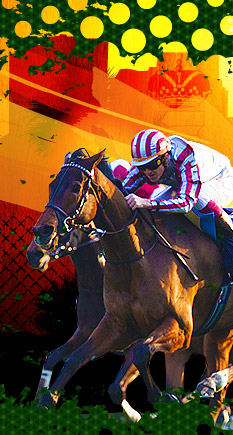
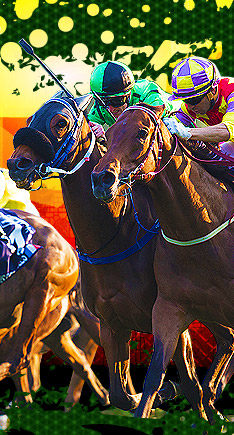
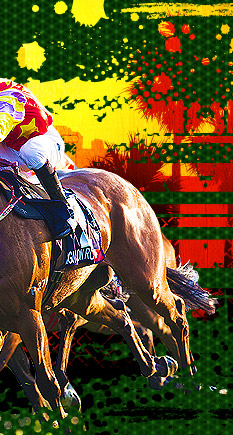
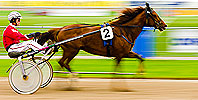 Harness Racing Generally speaking, the inside post positions (numbers one through four) are an advantage, especially on half-mile tracks.
Harness Racing Generally speaking, the inside post positions (numbers one through four) are an advantage, especially on half-mile tracks.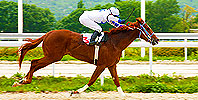 Thoroughbred Racing "Pace makes the race." This old racing expression points to another element to consider when placing your bets -- the pace of the race.
Thoroughbred Racing "Pace makes the race." This old racing expression points to another element to consider when placing your bets -- the pace of the race.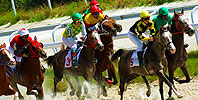 Quarter Horse Racing Straightaway American Quarter Horse racing is an all-out burst of speed from the starting gate with every horse trying to put a head in front at the finish.
Quarter Horse Racing Straightaway American Quarter Horse racing is an all-out burst of speed from the starting gate with every horse trying to put a head in front at the finish.